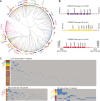Phylogenetic Distribution of CRISPR-Cas Systems in Antibiotic-Resistant Pseudomonas aeruginosa
- PMID: 26604259
- PMCID: PMC4669384
- DOI: 10.1128/mBio.01796-15
Phylogenetic Distribution of CRISPR-Cas Systems in Antibiotic-Resistant Pseudomonas aeruginosa
Abstract
Pseudomonas aeruginosa is an antibiotic-refractory pathogen with a large genome and extensive genotypic diversity. Historically, P. aeruginosa has been a major model system for understanding the molecular mechanisms underlying type I clustered regularly interspaced short palindromic repeat (CRISPR) and CRISPR-associated protein (CRISPR-Cas)-based bacterial immune system function. However, little information on the phylogenetic distribution and potential role of these CRISPR-Cas systems in molding the P. aeruginosa accessory genome and antibiotic resistance elements is known. Computational approaches were used to identify and characterize CRISPR-Cas systems within 672 genomes, and in the process, we identified a previously unreported and putatively mobile type I-C P. aeruginosa CRISPR-Cas system. Furthermore, genomes harboring noninhibited type I-F and I-E CRISPR-Cas systems were on average ~300 kb smaller than those without a CRISPR-Cas system. In silico analysis demonstrated that the accessory genome (n = 22,036 genes) harbored the majority of identified CRISPR-Cas targets. We also assembled a global spacer library that aided the identification of difficult-to-characterize mobile genetic elements within next-generation sequencing (NGS) data and allowed CRISPR typing of a majority of P. aeruginosa strains. In summary, our analysis demonstrated that CRISPR-Cas systems play an important role in shaping the accessory genomes of globally distributed P. aeruginosa isolates.
Importance: P. aeruginosa is both an antibiotic-refractory pathogen and an important model system for type I CRISPR-Cas bacterial immune systems. By combining the genome sequences of 672 newly and previously sequenced genomes, we were able to provide a global view of the phylogenetic distribution, conservation, and potential targets of these systems. This analysis identified a new and putatively mobile P. aeruginosa CRISPR-Cas subtype, characterized the diverse distribution of known CRISPR-inhibiting genes, and provided a potential new use for CRISPR spacer libraries in accessory genome analysis. Our data demonstrated the importance of CRISPR-Cas systems in modulating the accessory genomes of globally distributed strains while also providing substantial data for subsequent genomic and experimental studies in multiple fields. Understanding why certain genotypes of P. aeruginosa are clinically prevalent and adept at horizontally acquiring virulence and antibiotic resistance elements is of major clinical and economic importance.
Copyright © 2015 van Belkum et al.
Figures





Similar articles
-
Exploring the success of Brazilian endemic clone Pseudomonas aeruginosa ST277 and its association with the CRISPR-Cas system type I-C.BMC Genomics. 2020 Mar 23;21(1):255. doi: 10.1186/s12864-020-6650-9. BMC Genomics. 2020. PMID: 32293244 Free PMC article.
-
Molecular characterization and genome sequencing of selected highly resistant clinical isolates of Pseudomonas aeruginosa and its association with the clustered regularly interspaced palindromic repeat/Cas system.Heliyon. 2025 Jan 6;11(1):e41670. doi: 10.1016/j.heliyon.2025.e41670. eCollection 2025 Jan 15. Heliyon. 2025. PMID: 39866497 Free PMC article.
-
Molecular epidemiological study of Pseudomonas aeruginosa strains isolated from hospitals in Brazil by MLST and CRISPR/Cas system analysis.Mol Genet Genomics. 2025 Mar 20;300(1):33. doi: 10.1007/s00438-025-02239-5. Mol Genet Genomics. 2025. PMID: 40113632 Free PMC article.
-
Analysis of direct repeats and spacers of CRISPR/Cas systems type I-F in Brazilian clinical strains of Pseudomonas aeruginosa.Mol Genet Genomics. 2019 Oct;294(5):1095-1105. doi: 10.1007/s00438-019-01575-7. Epub 2019 May 16. Mol Genet Genomics. 2019. PMID: 31098740 Review.
-
CRISPR in Modulating Antibiotic Resistance of ESKAPE Pathogens.Mol Biotechnol. 2023 Jan;65(1):1-16. doi: 10.1007/s12033-022-00543-8. Epub 2022 Aug 8. Mol Biotechnol. 2023. PMID: 35939207 Review.
Cited by
-
Antibiotic Resistance in Pseudomonas.Adv Exp Med Biol. 2022;1386:117-143. doi: 10.1007/978-3-031-08491-1_5. Adv Exp Med Biol. 2022. PMID: 36258071
-
Metapopulation Structure of CRISPR-Cas Immunity in Pseudomonas aeruginosa and Its Viruses.mSystems. 2018 Oct 23;3(5):e00075-18. doi: 10.1128/mSystems.00075-18. eCollection 2018 Sep-Oct. mSystems. 2018. PMID: 30374457 Free PMC article.
-
Precise genome engineering in Pseudomonas using phage-encoded homologous recombination and the Cascade-Cas3 system.Nat Protoc. 2023 Sep;18(9):2642-2670. doi: 10.1038/s41596-023-00856-1. Epub 2023 Aug 25. Nat Protoc. 2023. PMID: 37626246 Review.
-
Pan genome and CRISPR analyses of the bacterial fish pathogen Moritella viscosa.BMC Genomics. 2017 Apr 20;18(1):313. doi: 10.1186/s12864-017-3693-7. BMC Genomics. 2017. PMID: 28427330 Free PMC article.
-
Intraclonal Genome Stability of the Metallo-β-lactamase SPM-1-producing Pseudomonas aeruginosa ST277, an Endemic Clone Disseminated in Brazilian Hospitals.Front Microbiol. 2016 Dec 5;7:1946. doi: 10.3389/fmicb.2016.01946. eCollection 2016. Front Microbiol. 2016. PMID: 27994579 Free PMC article.
References
-
- Stover CK, Pham XQ, Erwin AL, Mizoguchi SD, Warrener P, Hickey MJ, Brinkman FS, Hufnagle WO, Kowalik DJ, Lagrou M, Garber RL, Goltry L, Tolentino E, Westbrock-Wadman S, Yuan Y, Brody LL, Coulter SN, Folger KR, Kas A, Larbig K, Lim R, Smith K, Spencer D, Wong GK, Wu Z, Paulsen IT, Reizer J, Saier MH, Hancock RE, Lory S, Olson MV. 2000. Complete genome sequence of Pseudomonas aeruginosa PAO1, an opportunistic pathogen. Nature 406:959–964. doi:10.1038/35023079. - DOI - PubMed
MeSH terms
Substances
LinkOut - more resources
Full Text Sources
Medical

